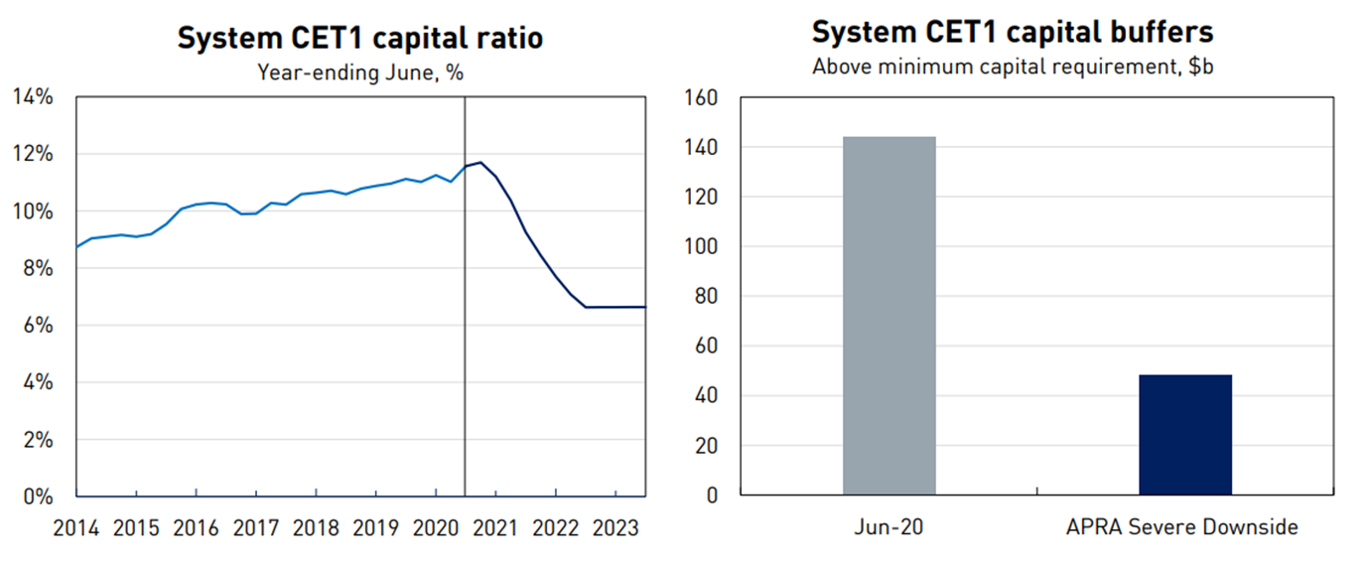Aussie banks prove indestructible
In the AFR today I write that Australia’s ferocious banking regulator has tried its darndest to blow-up our deposit-takers in the latest iteration of its ultra-aggressive stress-testing regime. The good news for savers, shareholders and creditors is that the Australian Prudential Regulation Authority (APRA) has failed in this effort to blow-up the banks despite it being its toughest-ever trial. Excerpt below:
The stress-test took place immediately following the COVID-19 shock and imposed the harshest assumptions APRA has ever dreamt-up. These included a record jump in the jobless rate to almost 14 per cent, house prices plunging 30 per cent, commercial property values falling an even larger 40 per cent, and two recessions over 2020 and 2021 as the economy suffered from a widespread second COVID-19 wave followed by a more geographically limited third-wave. The economic contraction in 2020 alone was assumed to account for 15 per cent of GDP, more than double what Australia actually experienced.
APRA comments that “the 'severe downside' scenario used in this [stress-test] featured a much sharper and deeper macroeconomic contraction than previous stress tests, reflecting the unprecedented speed and nature of the COVID-19 pandemic”. “It also featured a less pronounced recovery, reflecting ongoing uncertainty in both health and economic outcomes domestically and internationally.”
In APRA’s preceding 2017 and 2019 stress-tests the jobless rate was projected to rise to 11 per cent (compared to almost 14 per cent in this simulation). The ensuing reduction in the banks’ first-loss equity reserve buffers in 2017 and 2019 was around 3 to 3.5 percentage points, substantially less than 5 percentage point equity capital loss inflicted by APRA’s 2020 test.
And that is a critical point. Notwithstanding cumulative credit losses of $163 billion over the three-years, the banking industry’s all-important Common Equity Tier 1 (CET1) capital ratio of 11.6 per cent only shrunk to 6.6 per cent according to APRA.
This is notable for two reasons. First, it is above APRA’s minimum CET1 capital requirement of 4.5 per cent. And, secondly, it is higher than the 5.125 per cent threshold at which the banks’ hybrid securities are automatically converted into shares. These findings were also true when APRA focussed on the big banks with the median CET1 loss for the four majors sitting around 5 percentage points.

APRA emphasises that this analysis assumes the banks do absolutely nothing to mitigate the crisis: “The outcome from these stress test results is before accounting for any actions banks can deploy in response to stress, which are significant. This would include capital raisings, asset sales, repricing and expense reductions. Together, these steps can substantially offset the impact of credit losses on a bank’s capital position.”
APRA’s characteristic conservatism has been echoed in the federal government’s approach to its budget forecasts with Treasurer Josh Frydenberg revealing during the week that the deficit this financial year will be $16 billion smaller than he expected only two months ago as a result of Australia’s outperformance during the pandemic.
1 topic
4 stocks mentioned

